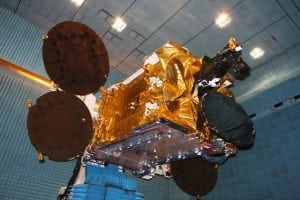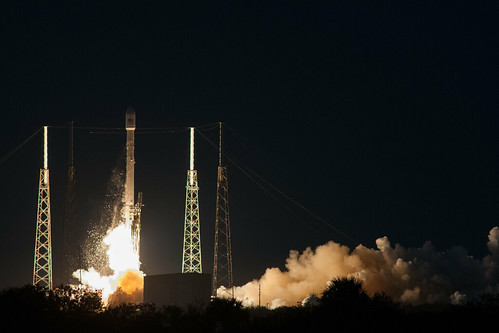Ariane 5 launches Athena-Fidus and ABS’s first built-to-order satellite. [Space News – 02/07/2014]
Experimental microsatellite launched three years ago for U.S. National Reconnaissance Office has operated nearly flawlessly according to manufacturer Millennium Space Systems’ press release also revealing some details about the classified launch. [Space News – 02/07/2014]

Proton M – © RIA Novosti. Oleg Urusov
Two Russian telecommunications satellites have been delivered to Baikonur in preparation for mid-March launch. [Ria Novosti – 02/07/2014]
U.S. satellite export regs remain a frustration for European industry. [Space News – 02/07/2014]

Credit: Exelis artist’s concept – Space News
Continuing problems with an Exelis-built payload will delay the delivery of the first of the GPS 3 next-generation navigation satellites. [Space News – 02/07/2014]
Canadian policy outlines broad national goals for space program. [Space News – 02/07/2014]
TCS gets $6.8m contract with U.S. Army for maritime-stabilized VSAT satellite systems and associated engineering systems. [Via Satellite – 02/07/2014]
SKY Perfect JSAT selects Kratos for command and control system for JCSAT-14 satellite. [Market Watch – 02/07/2014]
Globecomm founder and CEO David Hershberg to retire. [Satellite Markets & Research – 02/07/2014]

Credit: Astrium artist’s concept – Space News
Satellite builders likeliest to benefit from French satellite broadband funding. [Space News – 02/06/2014]
ST Electronics selects Antrix corporation to launch its first commercial satellite, TeLEOS-1 earth observation satellite, into a Near Equatorial Orbit. [Satellite Evolution Group – 02/06/2014]
ST Electronics to distribute its TeLEOS-1 satellite images globally, partnering with Satrec Initiative Co Ltd and SPOT Asia Pte Ltd. [Satellite Evolution Group – 02/06/2014]
The first Singapore-made commercial satellite will be put into orbit in the fourth quarter of next year. [Channel NewsAsia – 02/06/2014]
Airbus Defence and Space, formerly Astrium, has expands its Ku-band satellite services portfolio with new Terralink Companion Quick Deploy solution ideally suited for field communication in operations such as mining. [Mining Weekly – 02/06/2014]
Measat highlights satellite capabilities and announces launch of Measat 3b in May. [Via Satellite – 02/06/2014]
ViewSat to use Intelsat capacity to facilitate and enhance distribution service to the North American DTH market. [Via Satellite – 02/06/2014]
The Canadian Radio-television and Telecommunications Commission to look into wholesale satellite service to local telecom providers across far north. [IT World Canada – 02/06/2014]
KVH ships 4,000th TracPhone system for mini-VSAT broadband network. [Satellite Evolution Group – 02/06/2014]
Colombian state telco ETB acquires local satellite communications firm to improve nationwide offer for corporate and government clients. [BNamericas – 02/06/2014]

Credit – SpaceX photo – Space News
Next SpaceX station cargo run slips into March. [Space News – 02/05/2014]
ITC Global expands reach in U.K. and European energy industry with new operations in Aberdeen, Scotland. [IT Business Net – 02/05/2014]
Globalstar Sat-Fi MSS solution enables users to use any Wi-Fi capable device through an app and a Sat-Fi hot spot – targets two billion-people market.. [Via Satellite – 02/05/2014]
Using a repurposed commercial satellite, Air Force crews flew MQ-1 Predators and MQ-9 Reapers from Creech Air Force Base, Nev., during multiple missions in November and December. [U.S. Air Force – 02/05/2014]

Photo: SES – Via Satellite
SES’ Astra 2E satellite enters commercial service at 28.2/28.5 degrees east. [Via Satellite – 02/04/2014]

Inmarsat’s SF1 ready for launch – Photo: Inmarsat – Via Satellite
First of three Inmarsat Global Xpress satellites completes orbital deployment stages on scheduile. [Via Satellite – 02/04/2014]
Euroconsult to organise Latin American satellite summit [RAPIDTVNews – 02/04/2014]
Iridium introduces Wi-Fi hotspot, a high power broadcast service, and a maritime communications solution, and prepares for Iridium Next satellite replacement program [Via Satellite – 02/04/2014]
Globecomm Systems extends contract with Avanti Communications to deploy satellite broadband services in Cape Town and Johannesburg Africa. [Business Day – 02/04/2014]
AST works with SRI International to provide Iridium communications throughout the Arctic for safety of life purposes and tracking. [Via Satellite – 02/04/2014]
Hughes is providing broadband satellite Internet access to Yukon Quest dog sled crews. [Yahoo Finance – 02/04/2014]
SES-8 now fully operational, co-positioned with NSS-6 at 95 degrees East, to serve Asia Pacific region. [Yahoo Finance – 02/03/2014]
NSR’s take on Thuraya’s Satsleeve for Android – how it positions Thuraya in the addressable market, and how partnering with a competitor to enter the U.S. market could be of benefit. [NSR – 02/04/2014]
Hills Limited is partnering with BAE Systems to develop a commercial-off-the-shelf (COTS) terminal crucial to the satellite communication systems of Australian-USA and allied defence forces. [WhaTec – 02/04/2014]
Demand for Occasional Use (OU) and Satellite Newsgathering (SNG) is leveling out to a more regular year-over-year pace from the familiar even-odd year oscillation of demand in the past. [Via Satellite – 02/04/2014]
THAICOM launches fast Internet connectivity service, powered by Gilat satellite equipment. [Yahoo Finance – 02/03/2014]
After tests last year, “fifteen of fifteen company commanders found the” Soldier Network Extension (SNE) portion of the Army’s Warfighter Information Network “distracting and indicated they would not take the SNE to war.” [Nextgov – 02/03/2014]
Newtec and the European Broadcasting Union (EBU), sign a multimillion-euro contract to deploy Newtec’s satellite broadcast solutions as part of the EBU’s major pan-European news exchange network. [SatNews – 02/03/2014]
RigNet completes acquisition of Inmarsat’s energy broadband business. [IT Business Net – 02/03/2014]
Transaero Airlines is expanding its in-flight Internet and mobile connectivity communication services. [Via Satellite – 02/04/2014]

Arab Satellite Communications Organization (Arabsat) signs contract with Sudanese TV to broadcast the Sudanese TV channels bouquet exclusively on Arabsat satellites. [Korea IT News – 02/03/2014]
Australian telecommunications company Optus wins five-year satellite and broadband contract with NBN. [International Business Times – 02/03/2014]
Emerging Markets Communications (EMC) has enhanced its technology and infrastructure to deliver VSAT mobility services, currently active on trains across Europe and Africa. [Via Satellite – 02/03/2014]
Satcom Direct becomes an Inmarsat BGAN distribution partner. [Contact Center Solutions – 02/03/2014]
Iran unveils two domestically-made communication satellites, one to bolster its wireless connections and the other capable of taking high-resolution pictures, media reported. [ynet news – 02/03/2014]
“Satellite Manufacturing and Launching: The Dawn of a New Era” [NSR webinar February 12, 2014]
“High Utilization AND High Throughput Efficiency? Solving the TDMA vs. SCPC Dilemma” [Via Satellite webinar March 5, 2014]
WBMSAT satellite communications consulting services















